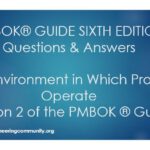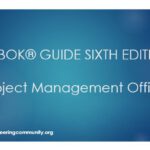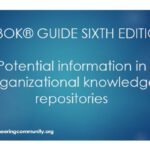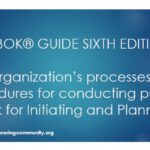
Project Communication Management Summary 6th Edition
27 June 2020Project Communication Management Summary 6th Edition
- An effective communications management plan is developed early in project life cycle.
- Misunderstandings can be reduced using the 5C’ (Correct grammar and spelling, Concise expression and elimination for excess words, Clear purpose and expression, Coherent logical flow of ideas and Controlling flow of words and ideas).
- Communication Requirements Analysis:
✓ Determines the information needs of the project stakeholders. These requirements are defined by combining the type and format of information needed with an analysis of the value of that information .
✓ Sources of information include (Stakeholder information, Number of potential communication channels, Organizational charts, Development approach, Internal and external information and Legal requirements).
- Communication Technology:
✓ Methods includes (Conversation, meetings, Written documents, Databases and Websites).
✓ Factors that affect the choice of communication include (Urgency of the need for information, Availability and reliability of technology, Ease of use, Project environment (face-to-face or virtual) and Sensitivity and confidentiality of the information).
- Communication Models:
✓ Sample basic sender/receiver communication model: This model consists two parties (sender and receiver). This model is concerned with ensuring that message is delivered, rather than understood.
▪ Encode: The message is coded into symbols, such as text, sound or some other medium.
▪ Transmit message: The message is sent via a communication channel.
The transmission of this message may be compromised by various physical factors (unfamiliar technology) or inadequate infrastructure. Noise may result in loss of information in transmission/reception .
▪ Decode: Data received is translated by the receiver back into a form useful to the receiver.
✓ Sample Interactive communication model: This model consists two parties (sender and receiver), but recognizes the need to ensure the message has been understood.
▪ Acknowledge: Upon receipt of a message, the receiver may signal (acknowledge) receipt of the message, but this does not necessarily mean agreement with or comprehension of the message.
▪ Feedback/response: When the received message has been decoded and understood, the receiver encodes thoughts and ideas into a message and then transmits this message to the original sender. If the sender perceives that the feedback matches the original message, the communication has been successful. Feedback can be achieved through active listening.
✓ The sender is responsible for the transmission of the message, ensuring the information being communicated is clear and complete and confirm the message is correctly interpreted.
✓ The receiver is responsible for ensuring that the information is received in its entirety, interpreted correctly and acknowledged or responded to appropriately.
- Communication Methods:
✓ Interactive communication: Between two or more parties performing a multidirectional exchange of information in real time like (Meetings, phone calls, video conferencing and instant messaging).
✓ Push communication: Sent or distributed directly to specific recipients who need to receive the information. Like (letters, memos, reports, emails, faxes, voicemail and blogs).
✓ Pull communication: Used for large complex information sets, or for large audiences, and requires the recipients to access content at their own discretion subject to security procedure. Like (web portals, intranet sites, e-learning, lessons learned databases or knowledge repositories).
- Interpersonal and Team Skills:
✓ Communication style assessment: A technique used to assess communication styles and identify the preferred communication method for planned communication activities.
✓ Political awareness: Helps the project manager to plan communications based on the project environment as well as organization’s political environment. Political awareness concerns the recognition of power relationships, both formal and informal and also the willingness to operate within these structures.
✓ Cultural awareness: Understanding of the difference between individual and groups and adapting the project’s communication strategy in the context of these differences. This minimize misunderstandings and miscommunications that may result in cultural differences.
- Communication Management Plan:
✓ The communications management plan is a component of the project management plan that describes how project communications will be planned, structured, implemented, and monitored for effectiveness.
✓ This communication management plan can include guidelines and templates for project status meetings, project team meetings, e-meetings, and email messages.
✓ It also contains “Escalation processes”.
- The Manage Communications process ensure that the information has been generated is appropriately generated and formatted and received by the intended audience. Also provides opportunities for stakeholders to make requests for further information and clarification.
- Communication Skills:
✓ Communication competence: A combination of tailored communication skills that considers factors such as clarity of purpose in key messages, effective relationships and information sharing, and leadership behaviors.
✓ Feedback: information about reactions to communications or a deliverable. Feedback supports interactive communication between the manager, team and stakeholders. Example (coaching, negotiating and mentoring).
✓ Nonverbal: Examples of nonverbal communication include appropriate body language to transmit meaning through gestures, tone of voice, and facial expressions, eye contact and Mirroring.
✓ Presentation: Formal delivery of information and/or documentation. Clear and effective presentations of project information to relevant stakeholders include (Progress reports, Background information, General information about the project and specific information on a subject).
- Project Reporting:
✓ Project reporting is the act of collecting and distributing project information.
✓ Reporting format may range from a simple communication to more elaborate custom reports.
✓ While work performance reports are the output of the Monitor and Control Project Work process, this process develops ad hoc reports, project presentations blogs.
- Interpersonal and Team Skills:
✓ Active Listening: Involve acknowledging, clarifying and confirming, understanding and removing barriers that adversely affect comprehension .
✓ Meeting management: taking steps to ensure meetings meet their intended objectives effectively and efficiently.
✓ Networking: interacting with others to exchange information and develop contacts. Networks provide the manager and the team access to informal organizations to solve problems, influence actions of their stakeholders, and increase stakeholder support for the work and outcomes.
✓ Political awareness: assists the project manager in engaging stakeholders appropriately to maintain their support throughout the project.
- Project Communications: Project communications artifacts includes: performance reports, deliverable status, schedule progress, cost incurred, presentations, and other information required by stakeholders.
- Monitor Communications process can trigger an iteration of the Plan Communications Management and/or Manage Communications processes to improve effectiveness of communication.
- Observation/Conversation: Discussion and dialogue with the project team helps determine the most appropriate way to update and communicate project performance, and to respond to requests from stakeholders for information. Also help the manager to detect any conflicts between people.








